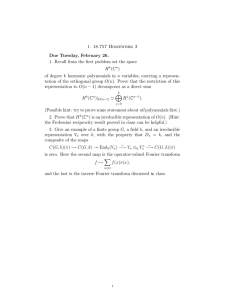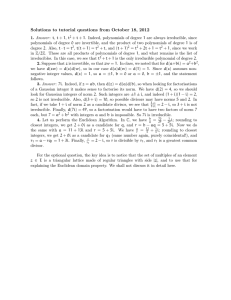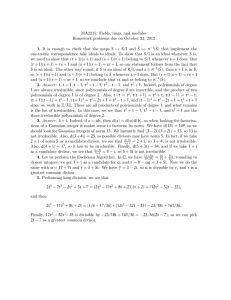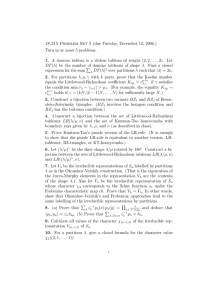Explicit formulae for Kerov polynomials P. Petrullo · D. Senato
advertisement
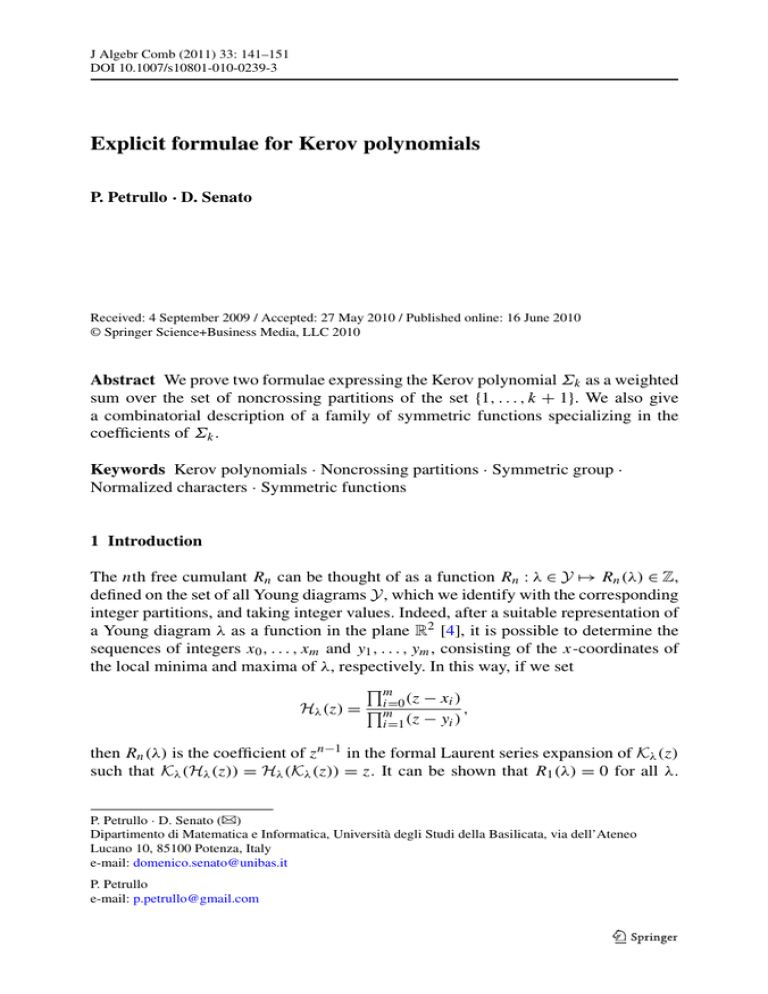
J Algebr Comb (2011) 33: 141–151
DOI 10.1007/s10801-010-0239-3
Explicit formulae for Kerov polynomials
P. Petrullo · D. Senato
Received: 4 September 2009 / Accepted: 27 May 2010 / Published online: 16 June 2010
© Springer Science+Business Media, LLC 2010
Abstract We prove two formulae expressing the Kerov polynomial Σk as a weighted
sum over the set of noncrossing partitions of the set {1, . . . , k + 1}. We also give
a combinatorial description of a family of symmetric functions specializing in the
coefficients of Σk .
Keywords Kerov polynomials · Noncrossing partitions · Symmetric group ·
Normalized characters · Symmetric functions
1 Introduction
The nth free cumulant Rn can be thought of as a function Rn : λ ∈ Y → Rn (λ) ∈ Z,
defined on the set of all Young diagrams Y, which we identify with the corresponding
integer partitions, and taking integer values. Indeed, after a suitable representation of
a Young diagram λ as a function in the plane R2 [4], it is possible to determine the
sequences of integers x0 , . . . , xm and y1 , . . . , ym , consisting of the x-coordinates of
the local minima and maxima of λ, respectively. In this way, if we set
m
(z − xi )
,
Hλ (z) = i=0
m
i=1 (z − yi )
then Rn (λ) is the coefficient of zn−1 in the formal Laurent series expansion of Kλ (z)
such that Kλ (Hλ (z)) = Hλ (Kλ (z)) = z. It can be shown that R1 (λ) = 0 for all λ.
P. Petrullo · D. Senato ()
Dipartimento di Matematica e Informatica, Università degli Studi della Basilicata, via dell’Ateneo
Lucano 10, 85100 Potenza, Italy
e-mail: domenico.senato@unibas.it
P. Petrullo
e-mail: p.petrullo@gmail.com
142
J Algebr Comb (2011) 33: 141–151
So, the kth Kerov polynomial is a polynomial Σk (R2 , . . . , Rk+1 ) which satisfies the
following identity,
χ λ (k, 1n−k )
,
Σk R2 (λ), . . . , Rk+1 (λ) = (n)k
χ λ (1n )
where χ λ (k, 1n−k ) denotes the value of the irreducible character of the symmetric
group Sn indexed by the partition λ on k-cycles. Two remarkable properties of Σk
have to be stressed. First, it is a “universal polynomial”, that is, it depends neither
on λ nor on n. Second, its coefficients are nonnegative integers. A combinatorial
proof of the positivity of Σk is quite recent and is due to Féray [8]. An explicit
combinatorial description of such coefficients is due to Doł˛ega, Féray and Śniady [6].
Until now, several results on Kerov polynomials have been proved and conjectured;
see, for instance, [5, 10, 12, 17] and [9] for a more detailed treatment.
Originally, free cumulants arise in the noncommutative context of free probability
theory [15]. To the best of our knowledge, their earliest applications in the asymptotic
character theory of the symmetric group are due to Biane; see, for instance, [3]. In
1994, Speicher [16] showed that the formulae connecting moments and free cumulants of a noncommutative random variable X obey the Möbius inversion on the lattice of noncrossing partitions of a finite set. This result highlights the strong analogy
between free cumulants and classical cumulants, which are related to the moments of
a random variable X, defined on a classical probability space, via the Möbius inversion on the lattice of all partitions of a finite set. More recently, Di Nardo, Petrullo
and Senato [7] have shown how the classical umbral calculus provides an alternative
setting for the cumulant families which passes through a generalization of the Abel
polynomials.
In 1997, it was again Biane [2] who showed that the lattice NCn of noncrossing partitions of {1, . . . , n} can be embedded into the Cayley graph of the symmetric group Sn . Thus it seems reasonable that a not too complicated expression of
the Kerov polynomials involving noncrossing partitions, or the Cayley graph of Sn ,
should exist. In particular, such a formula, conjectured in [4], appeared with a rather
implicit description in [6, 8].
In this paper, we state two explicit formulae relating Σk and the set NCk+1 of
noncrossing partitions of {1, . . . , k + 1}. More precisely, if NCirr
k+1 denotes the subset
of NCk+1 of partitions having 1 and k + 1 in the same block, then a new partial order
≤irr on NCirr
k+1 is considered, thanks to which we have
Σk =
(−1)π −1 Wτ (π) R .
τ ≤irr π
τ ∈NCirr
k+1
τ
Here, π is the number
of blocks of π , Wτ (π) is a suitable weight depending on τ
and π , and R = B R|B| , with B ranging over the blocks of τ having at least 2
τ
elements. The special structure of the weight Wτ (π) allows us to give a combinatorial description of the symmetric functions g μ (x1 , . . . , xk )’s, that evaluated at xi = i
return the coefficient of i≥2 Rimi in Σk , for every integer partition μ of size k + 1
having mi parts equal to i.
J Algebr Comb (2011) 33: 141–151
143
A second formula expressing Σk as a weighted sum over the whole NCk+1 is
proved by means of the notion of irreducible components of a noncrossing partition.
In particular, if dτ is the number of irreducible components of τ , then we have
Σk =
(−1)dτ −1 Vτ R ,
τ ∈NCk+1
τ
where Vτ is a suitable weight depending on τ .
2 Kerov polynomials
Let n be a positive integer and
let λ = (λ1 , . . . , λl ) be an integer partition of size n,
that is, 1 ≤ λ1 ≤ · · · ≤ λ
l and
i λi = n. Denote by Yn the set of all Young diagrams
of size n, and set Y = n Yn . From now on, an integer partition and its Young diagram will be denoted by the same symbol λ. Moreover, as is usual we write λ n if
λ is an integer partition of size n.
After a suitable representation of a Young diagram λ as a function in the
plane R2 [4], it is possible to determine the sequences of integers x0 , . . . , xm and
y1 , . . . , ym , consisting of the x-coordinates of its local minima and maxima, respectively. Then, by expanding the rational function
m
(z − xi )
Hλ (z) = i=0
m
i=1 (z − yi )
as a formal power series in z−1 one has Hλ (z) = z−1 + n≥1 Mn (λ) z−(n+1) . The
integer Mn (λ) is said to be the nth moment of λ. Now, define Kλ (z) = Hλ−1 (z),
(Kλ (z)) = z, and consider its expansion as a formal Laurent
that is Kλ (Hλ (z)) = Hλ
series, Kλ (z) = z−1 + n≥1 Rn (λ) zn−1 . Then, the integer Rn (λ) is named the nth
free cumulant of λ. It is not difficult to see that M1 (λ) = R1 (λ) = 0 for all λ. By
−1
= zKλ (z), we obtain
two formal power
setting Mλ (z) = z−1 Hλ (z
) and Rλ (z)
series in z, Mλ (z) = 1 + n≥1 Mn (λ) zn and Rλ (z) = 1 + n≥1 Rn (λ) zn , such that
Mλ (z) = Rλ z Mλ (z) .
(2.1)
Let μ n and denote by χ λ (μ) the value of the irreducible character of Sn indexed by λ on the permutations of type μ. So that, if μ = (k, 1n−k ), that is, μ1 = k
λ (k, 1n−k ) of the normalized character
and μ2 = · · · = μn−k+1 = 1, then the value χ
indexed by λ on the k-cycles of Sn is given by
χ λ (k, 1n−k )
,
χ
λ k, 1n−k = (n)k
χ λ (1n )
where (n)k = n(n − 1) · · · (n − k + 1). The kth Kerov polynomial is a polynomial Σk
in k commuting variables which satisfies the following interesting identity,
λ k, 1n−k .
Σk R2 (λ), . . . , Rk+1 (λ) = χ
144
J Algebr Comb (2011) 33: 141–151
If we think of Rn (λ) as the image of a map Rn : λ ∈ Y → Rn (λ) ∈ Z, then also Kerov
polynomials become maps Σk = Σk (R2 , . . . , Rk+1 ), which are polynomials in the
λ (k, 1n−k ). Since the coefficients of Σk depend neither on
Rn ’s, such that Σk (λ) = χ
λ nor on n, but only on k, such polynomials are said to be “universal”. A second
remarkable property of Kerov polynomials is that all their coefficients are positive
integers. This fact is known as the “Kerov conjecture” [11]. The first proof of the
Kerov conjecture was given with combinatorial methods by Féray [8]. By using rather
different techniques, the same author with Doł˛ega and Śniady [6] have then stated an
explicit combinatorial interpretation of such coefficients. The following formula for
Σk can be found in Stanley [17]. It is also stated in Biane [4], where the author quotes
it as a private communication with A. Okounkov.
Theorem 2.1 Let R(z) = 1 +
then we have
n≥2 Rn z
If F (z) = Rz(z) and G(z) = F −1z(z−1 ) ,
n.
1 −1 z ∞
G(z − j ).
k
k−1
Σk = −
(2.2)
j =0
More precisely, if [zn ]f (z) denotes the coefficient of zn in the formal power series f (z), then [z−1 ]∞ f (z) = [z]f (z−1 ). This way, Identity (2.2) states that Σk
is obtained by expressing the right-hand side in terms of the free cumulants Rn ’s.
Moreover, thanks
to the invariance of the residue under translation of the variable, if
M(z) = 1 + n≥1 Mn zn , then by virtue of (2.1) we have z G(z)−1 = M(z−1 ), and
(2.2) can be rewritten in the following equivalent form,
1 k+1 1 − j z
z
.
z
k
M( 1−j
z)
k
Σk = −
(2.3)
j =1
For all j = 1, . . . , k, we denote by λ j the image of the diagram λ under the translation of the plane given by x → x + j . The ith local minimum and maximum of
λ j are xi + j and yi + j, respectively, so that
m
z − (xi + j )
Hλj (z) = i=0
m
i=1 z − (yi + j )
z
1
Mλ
.
and Mλj (z) =
1 − jz
1 − jz
In this way, we may rewrite (2.3) as follows:
1
1 k+1 z
.
k
Mλj (z)
k
Σk = −
(2.4)
j =1
Denote by Rλj (z) the formal power series such that Mλj(z) = Rλj(zMλj(z)).
It is immediate to verify that
Rλj (z) = j z + Rλ (z).
(2.5)
J Algebr Comb (2011) 33: 141–151
145
3 Irreducible noncrossing partitions
A partition of a finite set S is an unordered sequence τ = {A1 , .
. . , Al } of pairwise
disjoint nonempty subsets of S, called the blocks of τ , such that i Ai = S. We say
that τ refines π , written τ ≤ π , if and only if each block of π is a union of blocks
of τ . If T ⊂ S, then the restriction of τ to T is the partition τ|T obtained by removing
from τ all the elements in S \ T .
Denote by [n] the set {1, . . . , n}. A partition τ = {A1 , . . . , Al } of [n] is said to
be noncrossing if and only if a, c ∈ Ai and b, d ∈ Aj implies i = j , whenever 1 ≤
a < b < c < d ≤ n. The set of all the noncrossing partitions of [n] isusually
denoted
1 2n
by NCn . Its cardinality equals the nth Catalan number Cn = n+1
.
The
reader
n
interested in this subject may refer to [1] and references therein for further details.
Now, if we set Rτ = R|A1 | · · · R|Al | then we can state the following beautiful formula,
due to Speicher [16], expressing the moments Mn ’s in terms of their respective free
cumulants Rn ’s:
Mn =
Rτ .
τ ∈NCn
Following Lehner [13], if 1 and n lie in the same block of a partition τ of [n], then we
say that τ is irreducible. Moreover, we denote by NCirr
n the set of all the irreducible
noncrossing partitions of [n]. Note that a partition of NCirr
n+1 is obtained from a partition of NCn simply by inserting n + 1 in the block containing 1. By taking the sum
of the monomials Rτ ’s, τ ranging in NCirr
n instead of NCn , one defines a quantity Bn
known as a boolean cumulant (see [13])
Bn =
Rτ .
(3.1)
τ ∈NCirr
n
In particular, if B(z) =
n≥1 Bn z
n,
then we have
M(z) =
1
.
1 − B(z)
(3.2)
If μ = (μ1 , . . . , μl ) is an integer partition of size n, set Rμ = Rμ1 · · · Rμl and
irr
define NCirr
μ to be the subset of NC n consisting of all the irreducible noncrossing
partitions of type μ. From (3.1) we have
Bn =
NCirr Rμ .
μ
(3.3)
μn
Moreover, thanks to the Lagrange inversion formula, we recover
Bn =
(n − 2)μ −1
1 n
z R(z)n−1 =
Rμ ,
n−1
m(μ)!
μn
(3.4)
146
J Algebr Comb (2011) 33: 141–151
where m(μ)! = m1 (μ)! · · · mn (μ)!, and mi (μ) is the number of occurrences of i as a
part of μ. By comparing (3.3) and (3.4), we deduce
irr (n − 2)μ −1
NC =
.
μ
m(μ)!
(3.5)
The notion of noncrossing partition can be given for any totally ordered set S. In
particular, NCirr
S will denote the set of all the noncrossing partitions of S, such that
the minimum and the maximum of S lie in the same block. Let us introduce a partial
order on NCirr
S.
Definition 3.1 (Irreducible refinement) Let τ, π ∈ NCirr
S . We say that τ refines π in
an irreducible way, and write τ ≤irr π , if and only if τ ≤ π and the restriction π|A , of
π to each block A of τ , is in NCirr
A . In particular, we say that π covers τ if and only if
τ ≤irr π and π is obtained by joining two blocks of τ .
For instance, let τ = {{1, 5}, {2, 3}, {4}}, π = {{1, 2, 3, 5}, {4}} and σ = {{1, 5},
irr
{2, 3, 4}}. Then τ, π, σ ∈ NCirr
5 and τ refines both π and σ . However, τ ≤ π and in
irr
particular π covers τ , while it is not true that τ ≤ σ , since τ|{2,3,4} = {{2, 3}, {4}} is
not irreducible.
The singletons of the noncrossing partitions will play a special role. For all τ ∈
NCn , we denote by U (τ ) the subset of [n] consisting of all the integers i such that
{i} is a block of τ , while τ will be the partition obtained from τ by removing its
irr
singletons. When τ, π ∈ NCirr
n and τ ≤ π , then πτ is the restriction of π to U (τ ).
Note that πτ ∈ NCU (τ ) .
We define a tree-representation for the partitions of NCirr
n in the following way.
Assume τ = {A1 , . . . , Al } ∈ NCirr
and
min
A
<
min
A
.
Construct
a labeled rooted
i
i+1
n
tree tτ by the following steps:
• Choose A1 as the root of tτ ;
• If 2 ≤ i < j ≤ l then draw an edge between Ai and Aj if and only if i is the biggest
integer such that min Ai < min Aj ≤ max Aj < max Ai ;
• Label each edge {Ai , Aj } with min Aj .
For example, if τ = {{1, 2, 7, 12}, {3, 5, 6}, {4}, {8, 9}, {10, 11}} then tτ is the following tree,
{1, 2, 7, 12}
3
10
8
{3, 5, 6}
{8, 9}
{10, 11}
4
{4}
Now, let E(τ ) be the set of labels of tτ , and choose j ∈ E(τ ). We denote by tτ,j the
tree obtained from tτ by deleting the edge labeled by j and joining its nodes (i.e.,
J Algebr Comb (2011) 33: 141–151
147
joining the blocks). In the following, we will say that tτ,j is the tree obtained from tτ
by removing j . Hence, tτ,3 is given by
{1, 2, 3, 5, 6, 7, 12}
10
4
8
{4}
{8, 9}
{10, 11}
Now, tτ,j is the tree-representation of an irreducible noncrossing partition, here denoted by τ{j } , whose blocks are the nodes of tτ,j . By construction, we have τ ≤irr τ{j }
and E(τ{j } ) = E(τ ) \ {j }. More generally, given a subset S ⊆ E(τ ), we denote by
τS the only partition whose tree tτS is obtained from tτ by successively removing all
labels in S. We note that τ∅ = τ and that τS depends only on the set S and not on the
order in which labels are chosen. The following proposition is easy to prove.
irr
Proposition 3.1 Let τ, π ∈ NCirr
n . Then, we have τ ≤ π if and only if π = τS for
some S ⊆ E(τ ). In particular, if (τ ) is the number of blocks of τ , then we have
σ | τ ≤irr σ = 2E(τ ) = 2(τ )−1 ,
where 2E(τ ) is the powerset of E(τ ), and
{σ | σ covers τ } = E(τ ) = (τ ) − 1.
4 Kerov polynomial formulae
By means of the results of previous sections, we are able to give new formulae for the
Kerov polynomials Σk . In particular, the first formula is related to the partial order
≤irr on the irreducible noncrossing partitions of the set [k + 1], instead the second
formula expresses Σk as a weighted sum over NCk+1 .
4.1 Kerov polynomials and irreducible refinement
irr
Let τ, π ∈ NCirr
k+1 with τ ≤ π , and let πτ = {A1 , . . . , Al }. Moreover, set Ai = ∅ for
i > l and define Wτ (π) to be such that
Wτ (π) =
1 w(1)|A1 | · · · w(k)|Ak | .
k!
w∈Sk
Theorem 4.1 We have
Σk =
τ ∈NCirr
k+1
τ ≤irr π
(−1)π −1 Wτ (π) R .
τ
(4.1)
148
J Algebr Comb (2011) 33: 141–151
Proof Let Bn (j ) = −[zn ](Mλj (z))−1 for all n ≥ 1, and set B0 (j ) = 1. Since
R1 (λ) = 0, then from (2.5), (3.1) and (3.2) we deduce
j u(π) R (λ),
(4.2)
Bn (j ) =
π
π∈NCirr
n
where u(π) = |U (π)|. The right-hand side in (2.4) is equal to
1
−
k
k
a zj
a1 ,...,ak ≥0
a1 +···+ak =k+1
j =1
k
1 (−1)μ −1
=
Bμi w(i) ,
Mλj (z) k μk+1 m(μ)!(k − μ )!
1
w∈Sk i=1
μ ≤k
where μ1 , . . . , μμ are the parts of μ and μi = 0 when i > μ . However, by taking
into account (3.5), we may rewrite it in the following form:
1
k!
(−1)π −1
π∈NCirr
k+1
k
B|Ai | w(i) ,
w∈Sk i=1
where A1 , . . . , Aμ are the blocks of π and Ai = ∅ if i > π . Moreover, by means of
identity (4.2), we obtain
k
w∈Sk i=1
B|Ai | w(i) =
w(1)u(τ1 ) · · · w(k)u(τk ) R (λ) · · · R (λ),
τ1
τ1 ,...,τk w∈Sk
τk
irr
where τi ranges over all NCirr
Ai , with NC ∅ = {∅}.
irr
Now, if we set τ = τ1 ∪ · · · ∪ τk , then τ ∈ NCirr
k+1 , τ ≤ π and Rτ (λ) =
R (λ) · · · R (λ). Finally, u(τi ) is the number of singletons in τi = τ|Ai , that is, the
τ1
τk
cardinality of the set Ai ∩ U (τ ), which if nonempty is a block of πτ . This completes
the proof.
Remark 4.1 Consider the polynomial Ωk (x1 , . . . , xk ) defined by
1 k+1 1 − xj z
z
.
k
M( 1−xz j z )
k
Ωk (x1 , . . . , xk ) = −
j =1
Of course, Ωk is symmetric with respect to the xi ’s. Moreover, by virtue of (2.3), we
obtain Ωk (1, 2, . . . , k) = Σk . A formula for Ωk (x1 , . . . , xk ) is obtained from (4.1)
simply by replacing w(j ) with xw(j ) in Wτ (π). More precisely, via Proposition 3.1,
if μ is an integer partition of size k + 1 then the coefficient of R in Ωk (x1 . . . , xk ) is
μ
g μ (x1 , . . . , xk ) =
(−1)|E(τ )|−|S| Wτ (S; x1 , . . . , xk ),
(4.3)
τ ∈NCirr
μ S⊆E(τ )
where R = i≥2 Ri mi (μ) , and where Wτ (S; x1 , . . . , xk ) is obtained by replacing
μ
w(j ) with xw(j ) in Wτ (τS ). Now, let λτ (S) denote the integer partition corresponding
J Algebr Comb (2011) 33: 141–151
149
to the type of πτ , with π = τS . Then, it is not difficult to see that
k!Wτ (S; x1 , . . . , xk ) = m λτ (S) ! k − λτ (S) !mλτ (S) (x1 , . . . , xk ),
with mλτ (S) (x1 , . . . , xk ) being the monomial symmetric function indexed by the partition λτ (S) [14]. This way, the coefficient of R in Ωk (x1 , . . . , xk ) is a symmetric
μ
function g μ (x1 , . . . , xk ) of degree m1 (μ). Assume that
g μ (x1 , . . . , xk ) =
gμ,λ mλ (x1 , . . . , xk ).
λ
The left-hand side of (4.3) says that, for every λ of size m1 (μ), we have
gμ,λ =
1 (−1)|E(τ )|−|S| m(λ)!(k − λ )!,
k!
irr S⊆E(τ )
τ ∈NCμ
λτ (S)=λ
thus we have provided a combinatorial formula for the gμ,λ ’s.
Finally, we stress that the coefficients in the expressions of g μ in terms of the
classical basis, and Schur basis, are not positive integers. Indeed, we have
4
3
4
g (3,1,1,1) = m(1,1,1) − m(1,2) + m(3) .
5
5
5
4.2 Kerov polynomials via irreducible components of noncrossing partitions
We will state a second formula expressing Σk as a weighted sum over the whole
NCk+1 . To this end, we introduce the notion of an irreducible component of a noncrossing partition.
Given τ ∈ NCn , let j1 be the greatest integer lying in the same block as 1. Set
τ1 = τ|[j1 ] so that τ1 is an irreducible noncrossing partition of [j1 ]. Now, let j2
be the greatest integer lying in the same block of j1 + 1 and set τ2 = τ|[j1 +1,j2 ] .
By iterating this process, we determine the sequence of irreducible noncrossing
partitions τ1 , . . . , τd , which we name the irreducible components of τ , such that
τ = τ1 ∪ · · · ∪ τd . For all τ ∈ NCn , we denote by dτ the number of its irreducible
components. Note that dτ = 1 if and only if τ is an irreducible noncrossing partition.
Theorem 4.2 We have
Σk =
(−1)dτ −1 Vτ R ,
τ ∈NCk+1
τ
where
Vτ =
1
k 1≤i <···<i
1
if d = dτ .
d ≤k
i1 u(τ1 ) · · · id u(τd ) ,
(4.4)
150
J Algebr Comb (2011) 33: 141–151
Proof Let Bλj (z) = 1(Mλj (z))−1 . From (2.4) we obtain
Σk = −
k
1 k+1 z
1 − Bλj (z)
k
j =1
=
k
(−1)d−1
d=1
k
k+1 z
Bλi1 (z) · · · Bλid (z).
1≤i1 <···<id ≤k
Of course, the complex Bn (j ) = [zn ]Bλj (z) is the n-boolean cumulant of λ j and
satisfies (4.2). This way we deduce
k+1 z
Bλi1 (z) · · · Bλid (z) =
i1 u(π1 ) · · · id u(πd ) R · · · R ,
a1 ,...,ad ≥1
a1 +···+ad =k+1
π1 ,...,πd
π1
πd
where πi ranges over NCirr
ai . Let a0 = 0 and consider the intervals Ai = [a0 + · · · +
ai−1 + 1, a0 + · · · + ai ] for i = 1, . . . , k + 1. Each translation h ∈ [1, ai ] → h + a0 +
irr
· · · + ai−1 ∈ Ai induces a bijection π ∈ NCirr
ai → τ ∈ NC Ai . Hence, in the identity
above we may replace each πi with the corresponding τi obtaining
k+1 Bλi1 (z) · · · Bλid (z) =
i1 u(τ1 ) · · · id u(τd ) R · · · R .
z
a1 ,...,ad ≥1
τ1 ,...,τd
a1 +···+ad =k+1
τ1
τd
Now, set τ = τ1 ∪ · · · ∪ τd so that τ ∈ NCk+1 , τi is the ith irreducible component of τ ,
and (4.4) follows.
Acknowledgement The authors thank the referees for their useful remarks and suggestions improving
the technical quality of the paper.
References
1. Armstrong, D.: Generalized noncrossing partitions and combinatorics of Coxeter groups. Mem. Am.
Math. Soc. 202, 949 (2009)
2. Biane, P.: Some properties of crossings and partitions. Discrete Math. 175, 41–53 (1997)
3. Biane, P.: Representations of symmetric groups and free probability. Adv. Math. 138(1), 126–181
(1998)
4. Biane, P.: Characters of the Symmetric Group and Free Cumulants. Lecture Notes in Math., vol. 1815,
pp. 185–200. Springer, Berlin (2003)
5. Biane, P.: On the formula of Goulden and Rattan for Kerov Polynomials. Sémin. Lothar. Comb. 55
(2006)
6. Doł˛ega, M., Féray, V., Śniady, P.: Explicit combinatorial interpretation of Kerov character polynomials as number of permutation factorizations. Adv. Math. (2010). doi:10.1016/j.aim.2010.02.011
7. Di Nardo, E., Petrullo, P., Senato, D.: Cumulants and convolutions via Abel polynomials. Eur. J.
Combin. (2010). doi:10.1016/j.ejc.2010.03.002
8. Féray, V.: Combinatorial interpretation and positivity of Kerov’s character polynomials. J. Algebr.
Comb. 29, 473–507 (2009)
9. Féray, V.: Fonctions sur l’ensemble des diagrammes de Young: caractères du groupe symétrique et
polynômes de Kerov. Ph.D. thesis (2009). Available at http://feray.fr/valentin/Math/Feray_these.pdf
J Algebr Comb (2011) 33: 141–151
151
10. Goulden, I.P., Rattan, A.: An explicit form for Kerov’s character polynomials. Trans. Am. Math. Soc.
359, 3669–3685 (2007)
11. Kerov, S.V.: Talk at IHP Conference (2000)
12. Lassalle, M.: Two positive conjectures for Kerov polynomials. Adv. Appl. Math. 41, 407–422 (2008)
13. Lehner, F.: Free cumulants and enumeration of connected partitions. Eur. J. Comb. 22, 1025–1031
(2002)
14. Macdonald, I.G.: Symmetric Functions and Hall Polynomials, 2nd edn. Oxford University Press, London (1995)
15. Nica, A., Speicher, R.: Lectures on the Combinatorics of Free Probability. Cambridge University
Press, Cambridge (2006)
16. Speicher, R.: Multiplicative functions on the lattice on nocrossing partitions and free convolution.
Math. Ann. 298, 611–628 (1994)
17. Stanley, R.P.: Kerov’s character polynomial and irreducible symmetric group characters of rectangular
shape. Transparencies from a talk at CMS meeting, Quebec City (2002)

